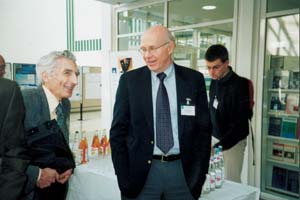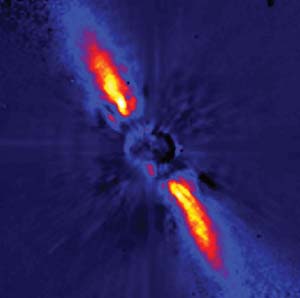Europe’s three principal physics research organizations, CERN, ESA and ESO, held a joint symposium in Munich in March. Maurice Jacob gives a glimpse of what proved to be a busy first encounter.

Astrophysics, particle physics, cosmology and fundamental physics in space have much in common to bring their practitioners together. CERN and the European Southern Observatory (ESO) have already held several joint symposia, and in 2000 a workshop organized by CERN and the European Space Agency (ESA) was held in Geneva. In March this year, some 200 scientists travelled to ESO’s headquarters near Munich for the first symposium to be hosted by all three organizations.
Following an introduction from ESO’s director-general, Catherine Cesarsky, the global properties and evolution of the universe took centre stage. These have been studied in terms of a few parameters whose values have been broadly established in a remarkably short time. The universe is flat with a critical density (W = 1), but baryons constitute only about 5%. Dark non-baryonic matter accounts for 25% of the overall density, and about 70% is “dark energy” with a negative pressure accelerating the expansion of the universe. All these contributions to the overall density should be precisely known within a decade. The apparent concordance of the parameters describing the universe obtained through very different measurements is already impressive, and leads to the question of why these parameters have the values they do.
Some speakers were even tempted to raise the anthropic principle, although this tenacious myth is neither quantitative nor falsifiable, and does not teach us anything new. Nevertheless, it has gathered new momentum within a framework where many different universes could have been born, or even within a single universe where widely differing domains could exist and where we happen to live in the one domain providing for our needs.
Global properties

The global properties of the universe were covered in the opening sessions. Neil Turok of Cambridge spoke about the very early universe – past and future – since the universe he proposed has a succession of Big Bangs and Big Crunches. After discussing the different contributions to W, Turok stressed that each measurement has little value on its own unless it is assessed within a particular theoretical framework, and that we should keep challenging the framework.
An explanation for many observed features is found in the standard inflationary universe scenario, which Turok challenged with a model of colliding branes. He called for an open-minded approach to such ideas, and for further tests of inflation such as the polarization of the cosmic microwave background (CMB) and the observation of a background of long-wavelength gravitational waves.
Paolo de Bernardis of the University of Rome reviewed CMB properties from an experimental point of view. The key result is the flatness of the universe, but the observation of peaks in the angular analysis of the CMB are what have allowed the baryonic density to be pinned down to 5%, and shown that temperature fluctuations are scale-independent. De Bernardis stressed, however, that measurements are currently restricted to a very limited coverage of the sky. This will be much extended with NASA’s MAP and ESA’s Planck missions, which will also measure CMB polarization.

A key feature is the current acceleration of the universe’s expansion, direct evidence for which comes from observations of supernovae. ESO’s Bruno Leibundgut showed how the observation of 27 low-redshift type 1a supernovae has built confidence that they are reliable standard candles. This has allowed observations of 54 high-redshift ones to be interpreted as fainter than expected from standard Hubble expansion. Taken at face value, this could result from a vacuum energy density of 0.7, which accelerates expansion today but would have led to a deceleration in the past when the matter density was higher. Leibundgut added a cautionary note, however, saying that much remains to be understood about the systematic uncertainties of type 1a supernovae. Much larger statistics, probing to higher redshift, are needed, as is a better understanding of the their explosion. Yannick Mellier of the Observatoire de Paris reviewed the complementary determination of the matter density via weak gravitational lensing. There is good agreement on the matter and vacuum density between six different teams. When combined with the analysis of the CMB, the matter density is pinned down to around 0.3 and the vacuum density to around 0.7. It is puzzling that the vacuum energy density should be so tiny compared with the Planck scale or electroweak breaking scale.
Dark matter
Direct searches for dark matter were reviewed by Charling Tao of Marseille. After recalling the first hints provided by the rotation curves of galaxies, interpreted as being due to a halo of baryonic matter, she explained how massive compact halo objects identified through gravitational lensing are too few to account for the effect. Underground experiments have looked for weakly interacting massive particles, so far to no avail. Concluding the discussion of exotic dark matter candidates was Georg Raffelt of the Max Planck Institute (MPI) in Munich, who described the CERN axion solar telescope, CAST.
With their tiny but non-zero masses, neutrinos provide the first clear departure from the Standard Model of particle physics, but are no longer expected to provide an appreciable contribution to dark matter. Pilar Hernandez of CERN reviewed the status of neutrino physics. Oscillations with mass square differences of the order of 10-3-10-5 eV2 and maximal mixing are now favoured.

Reviews of the Standard Model of particle physics and the exciting prospects for research at CERN’s forthcoming Large Hadron Collider were the subject of many presentations. Antonio Pich of Valencia spoke of low-energy Standard Model tests, while CERN’s Fabiola Gianotti covered high-energy tests. John Ellis of CERN went beyond the Standard Model, raising the possibility of extra dimensions at short distances as a rival to supersymmetry.
Studying the extreme
Edward van den Heuvel of Amsterdam reviewed gamma-ray bursts (GRBs). A beautiful example of serendipity, GRBs were discovered while looking for something else – nuclear tests in the atmosphere. Now known as the most powerful cosmic explosions, they occur at the level of one per day with energy output reaching that of up to a million supernovae. They last from seconds to minutes and appear at random in the sky, which is to be expected, since their X-ray and visible afterglows are associated with highly redshifted host galaxies. Many efforts are underway to observe and study GRBs with redshifts up to z = 12.
Remaining with the extreme, Heinrich Völk of Heidelberg discussed very-high-energy gamma rays, and Alan Watson of Leeds talked about the highest-energy cosmic rays. The observation of cosmic rays above about 1011 GeV is a puzzle, since as Greisen, Zatsepin and Kuzmin pointed out, the CMB should make space opaque to them. Understanding their origin will rely on observations with the Auger observatory and later with ESA’s Extreme Universe Space Observatory.
Francis Halzen from the University of Wisconsin-Madison talked about high-energy neutrinos from astrophysical sources. Detection at rates appropriate for meaningful study demands very large detectors such as the 1 km3 Icecube detector being installed deep under Antarctic ice, and underwater detectors such as ANTARES.
One session was devoted to massive objects. It now seems likely that massive black holes at the centre of galaxies fuel the massive energy output of quasars, equivalent to 1012-1015 suns, and that all galaxies were once active. Quasar density peaks at a redshift of z = 2. In closer galaxies, the presence of a relatively quiet black hole of millions of solar masses is inferred from the swift motion of stars around a dark centre. The central part of our Milky Way, for example, has been observed to within 3 light years of the centre, where stars circle at velocities up to 1500 km/s. Interpretations more exotic than the presence of a giant black hole are not expected to hold.
Gravitational waves
Bernhard Schutz of the MPI in Potsdam gave a review of gravitational wave sources, while Karsten Danzmann of the MPI in Hannover discussed experimental searches. Gravitational waves carry huge energies but interact very feebly, crossing the universe almost unperturbed. Ground-based detectors, sensitive to frequencies above 10 Hz, are complementary to detectors in space, which will look for frequencies below 0.1 Hz. Both should be sensitive to amplitudes below 1022. In his talk, Stephano Vitale of Trento discussed several ESA fundamental physics missions including SMART-2, a test mission for the ambitious LISA gravitational wave interferometer, which should fly in 2006.
Other forthcoming space experiments include the ESA-NASA STEP mission, which will test the equivalence principle to six orders of magnitude better than the present limit. Roberto Battiston of Perugia described Alpha Magnetic Spectrometer (AMS) findings on properties of the cosmic-ray flux, and showed how future AMS missions could bring down the anti-helium to helium ratio from 10-6 to around 10-9.
Planetary systems
Ewine van Dishoeck of Leiden discussed the formation of star and planetary systems from large clouds of gas and dust, saying that around 15% of stars have a disk from which planets could form. Solar system formation would take some 100 million years. This field will soon see major developments with new tools such as the Atacama Large Millimetre Array, ESA’s Infrared Space Observatory, NASA’s Space Infra Red Telescope Facility and the Next Generation Space Telescope.
Michel Mayor of Geneva recalled that more than 80 extra solar planets have already been seen, some of them with masses as low as 50 times the mass of the Earth. He discussed how planets are found through radial velocity surveys and planetary transit, the latter giving direct evidence for gaseous giants like Jupiter. The diversity of planets observed was not anticipated – some have very short periods, elongated orbits or very large masses up to 10 times the mass of Jupiter. Michael Perryman of ESA showed how missions under study could make the search for Earth-like planets possible, saying these may be as numerous as one per thousand stars. Many conditions, however, would need to be satisfied to make life possible. Perryman outlined a “habitable zone” requiring the presence of a Jupiter-type planet as a protection against meteorites, and stressed that it would need to exist over billions of years.
The meeting drew to a close with presentations about future directions at CERN, ESA and ESO. Exciting projects are being completed, are under construction or are at the planning stage in all three organizations. The closing lecture was given by Martin Rees of Cambridge, who brought the symposium to a brilliant finale with the conclusion that we live in exciting times.
Further reading
ESA SP-469 2001 Fundamental Physics in Space & Related Topics.
Europhysics News 2001 “Physics and the Universe” 32-6.
Proceedings of the 2002 ESO-CERN-ESA symposium, Springer Verlag (to be published).








